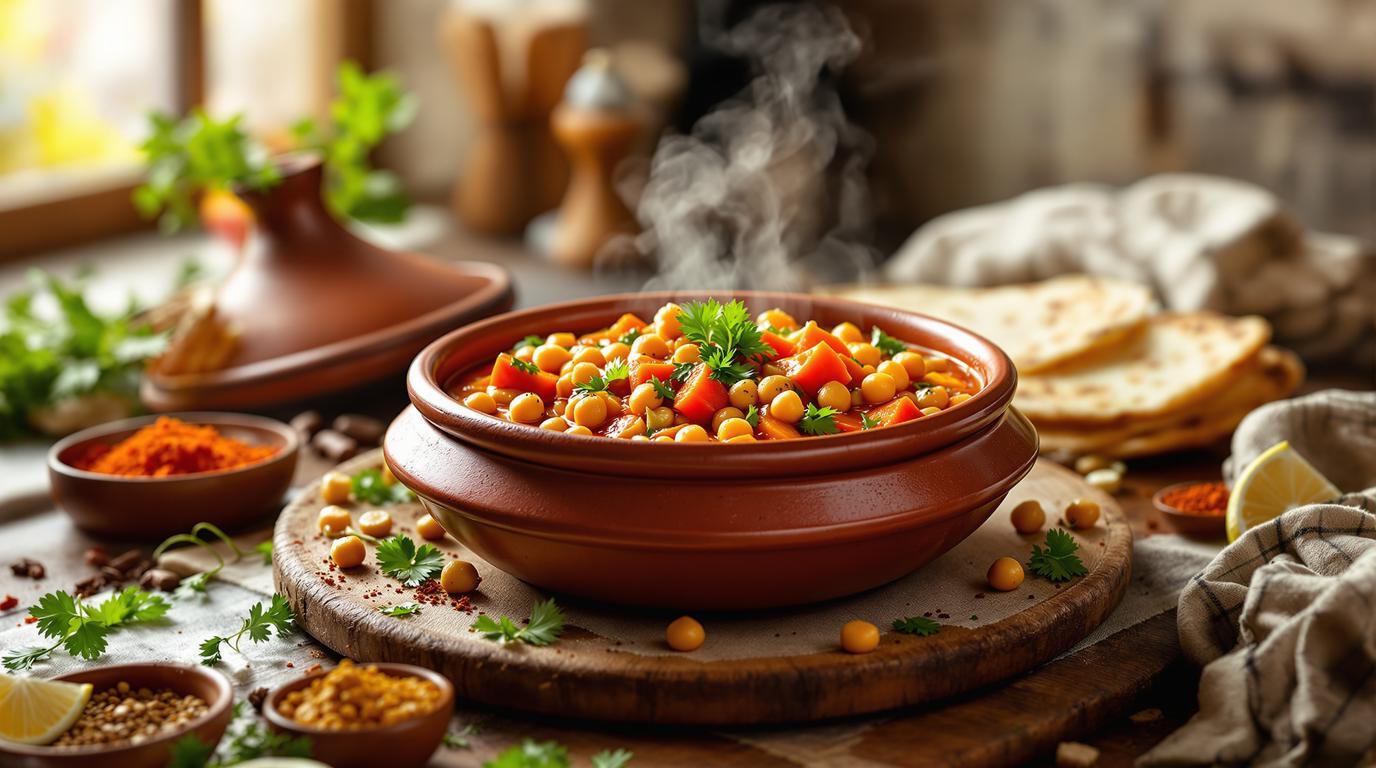There’s something magical about a simmering pot of Moroccan stew that transforms my kitchen into a sensory journey through North African souks. I first encountered traditional harira during my culinary travels through Marrakech, where I watched grandmothers stir enormous pots with practiced precision. What struck me most wasn’t just the complex layering of spices, but how this humble chickpea stew served as both daily sustenance and celebratory dish during Ramadan. Today, I’m sharing my take on this soul-warming classic that honors tradition while adapting to the modern home kitchen.
The Story Behind Moroccan Chickpea Stew 📖
This hearty stew draws inspiration from traditional harira, a cornerstone of Moroccan cuisine. While classic harira often includes lentils and sometimes meat, my version focuses on plump chickpeas as the protein star. What makes this dish truly special is harissa – a fiery North African chili paste that adds both heat and depth. Each region of Morocco has its own subtle variations – coastal areas might add fish, mountain villages often use more root vegetables, and southern regions tend to incorporate dried fruits for sweetness.
What I love most about this recipe is how it embodies the Moroccan philosophy of balancing sweet, savory, and spicy elements in perfect harmony. It’s a one-pot wonder that delivers extraordinary flavor with relatively simple ingredients – exactly the kind of cooking I gravitate toward after decades in professional kitchens.
Essential Ingredients 🧾
For 4 generous servings, you’ll need:
- 2 tablespoons olive oil (30ml)
- 1 large yellow onion, finely diced
- 3 garlic cloves, minced
- 2 medium carrots, diced into ½-inch pieces
- 1 large potato, cut into ¾-inch cubes (optional but adds lovely texture)
- 2 tablespoons tomato paste
- 1 tablespoon harissa paste (more or less to taste)
- 1 teaspoon ground cumin
- 1 teaspoon ground coriander
- 1 teaspoon paprika (sweet, not smoked)
- 1 teaspoon ground turmeric
- ½ teaspoon cinnamon
- 1 can (14 oz/400g) diced tomatoes
- 1 can (14 oz/400g) chickpeas, drained and rinsed
- 6 cups (1.4 liters) vegetable stock
- Juice of 1 lemon
- ¼ cup fresh cilantro, chopped
Step-by-Step Instructions 📝
- Develop Base Flavors: Heat olive oil in a large, heavy-bottomed pot over medium heat. Add diced onion with a pinch of salt and cook until translucent and just beginning to caramelize at the edges, about 5-6 minutes. Add minced garlic and cook for another minute until fragrant but not browned.
- Layer the Vegetables: Add diced carrots and potato (if using) to the pot. Cook for 3-4 minutes, stirring occasionally, until they begin to soften slightly.
- Bloom the Spices: Stir in the tomato paste and harissa, coating the vegetables evenly. Add all the dry spices (cumin, coriander, paprika, turmeric, and cinnamon). Cook for 2-3 minutes, stirring constantly – this crucial step “blooms” the spices, releasing their essential oils and deepening flavor.
- Build the Stew: Pour in the canned tomatoes with their juices, drained chickpeas, and vegetable stock. Bring to a gentle boil, then reduce heat to maintain a steady simmer. Cover partially and cook for 30 minutes, or until vegetables are tender and flavors have melded beautifully.
- Brighten and Finish: Remove from heat and stir in fresh lemon juice and chopped cilantro. Taste and adjust seasoning with salt and pepper as needed. Allow to rest for 5 minutes before serving.
Chef’s Note: The flavor of this stew actually improves overnight as the spices continue to meld. If you can resist finishing it all at once, refrigerate leftovers and enjoy even deeper flavors the next day. I often make a double batch specifically for this reason!
Chef’s Secret Techniques 🤫
The real magic of this stew lies in properly blooming the spices. In professional kitchens, we never add dry spices directly to liquid – this creates a flat, sometimes bitter flavor profile. Instead, gently toast them in oil until they become fragrant before adding any liquid ingredients. This simple technique transforms ordinary spices into extraordinary flavor.
If you can’t find harissa paste, make a quick substitute by mixing ½ teaspoon red pepper flakes, 1 extra minced garlic clove, ¼ teaspoon caraway seeds (crushed), and a splash of olive oil. While not identical to traditional harissa, it’ll provide similar heat and depth to your stew.
For an authentic twist, try adding a cinnamon stick and 2-3 whole cloves along with your spices, removing them before serving. This technique, which I learned from a Moroccan grandmother in Fez, infuses the broth with subtle aromatic notes that powdered spices simply can’t achieve.
Serving & Presentation Tips 🍽️
In Morocco, this stew would traditionally be served with warm, pillowy flatbread or fluffy couscous to soak up the flavorful broth. For a complete meal, I recommend serving in wide, shallow bowls with a small mound of couscous on one side and the stew generously ladled beside it.
Garnish with additional fresh cilantro, a wedge of lemon, and if you’re feeling indulgent, a small dollop of Greek yogurt to temper the heat. The contrast of the cool, tangy yogurt against the warm, spiced stew creates a beautiful sensory experience.
This hearty stew has traveled with me from professional kitchens to family dinners, always receiving warm praise. The beauty of Moroccan cooking lies in its ability to transform humble ingredients into something truly magnificent through careful spicing and gentle simmering. I hope this recipe brings as much joy to your table as it has to mine through the years. Remember, cooking is not just about following steps – it’s about creating moments and memories around the table. Enjoy the process as much as the result! For more comforting classics, check out my 2-Ingredient Homemade Ice Pops, Dreamy Coconut Oats, Grandma’s 6-Fold Trick for Heavenly Flaky Biscuits, Protein-Packed Overnight Oats, or 15-Minute Caprese Chicken Pasta.
